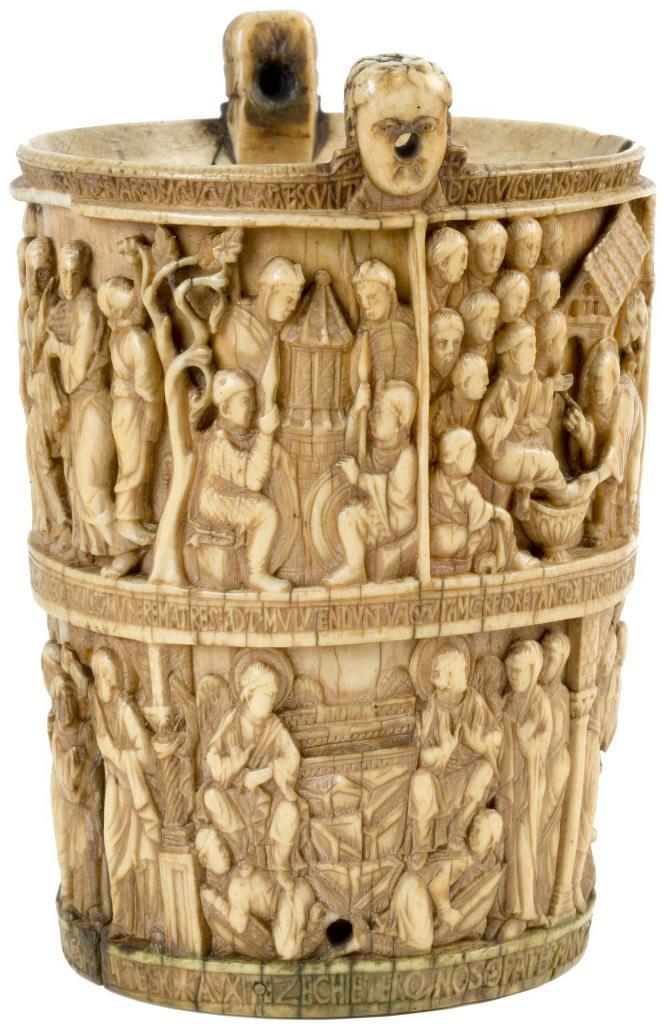Shop Amazon - Create an Amazon Baby Registry

Register a SNAP EBT card with Amazon
Basilewsky Situla, Soldiers at the Sepulchre
Ottonian Milan, Italy, c.980AD, Victoria and Albert Museum

A larger detail of the Soldiers at the Sepulchre, Basilewsky Situla, Ottonian Milan, Italy, c.980AD, Victoria and Albert Museum
The Basilewsky Situla
Object: Situla
Place of origin: Milan (made)
Date: 980-981 (made)
Artist/Maker: Unknown
Materials and Techniques: Ivory
Museum number: A.18-1933
Physical description:
The holy water bucket (situla), bears twelve scenes from the Passion and Resurrection of Christ, arranged in two superimposed rows.
In the upper row: Christ washing the Disciples’ feet, the Betrayal of Christ, Judas accepting the 30 pieces of silver from the high priest, the Crucifixion,
Judas returning the money to the High Priest, Judas hanging himself, the soldiers watching the Sepulchre.
In the lower row: the Maries at the Sepulchre, the Harrowing of Hell, Christ Appearing to the Women, Christ Appearing to the Apostles, and the Incredulity of St Thomas.
Two human mask-heads stand up from the top rim, pierced at the back to take the ends of a metal handle. 3 bands of inscription.
The two upper bands contain lines from the Carmen Paschale, a fifth-century hexameter rendering of the Old and New Testaments by Sedulius.
A situla is a bucket designed to hold holy water. Ivory situlae are very rare and were apparently only made for special ceremonial occasions.
Among the few situale which survive, this example stands out in the unusually high quality of its workmanship, and the great beauty of its composition.
It was probably made around 980 for the visit of the German Holy Roman Emperor Otto II to Milan.
Three situlas from the Ottonian period have survived, one in Milan of about 979, the present,
and one in Aachen of about 1000.
Ivory situlas were made for special ceremonial occasions, such as an Imperial visit and used to remain in the church visited by the Emperor.
The situla and a relief of Christ enthroned with the Emperor Otto II, his wife and child, both in Milan relate stylistically to the present situla.
The relationship of the two situlae and the relief suggests that they were all made in the same place (although not necessarily in the same workshop)
and Milan is the most likely centre of origin.
Source: Victoria and Albert Museum A.18-1933
Referenced on p.25, The Age of Charlemagne (Men-at-Arms 150) by D.Nicolle, A.McBride
An ivory situla from Milan c. 980 AD. The mailed warriors wear helmets with apparent combs or ridges along the crown. (V & A Museum, n.A.18 1933, London)
Referenced on p.41, Carolingian Cavalryman AD 768-986 by D. Nicolle
This carved ivory holy water bucket was probably made in Milan around 980.
Its portrayal of four guards outside the Holy Sepulchre shows men in short-sleeved mail hauberks and helmets with either plume-holders or two-piece construction.
(Victoria and Albert Museum, inv. A.18-1933, London, England)
See also A Carolingian banner in the Psalter of St. Bertin, Northern France, c. 1000 AD. BM. Boulogne Ms. 20
Elfenbeinsitula des Aschener Domschatz. Ivory Situlae of Aachen Cathedral, Ottonian, c.1000AD
Other Carolingian Illustrations of Costume and Soldiers
Italian Illustrations of Costume and Soldiers
10th Century Illustrations of Costume and Soldiers

